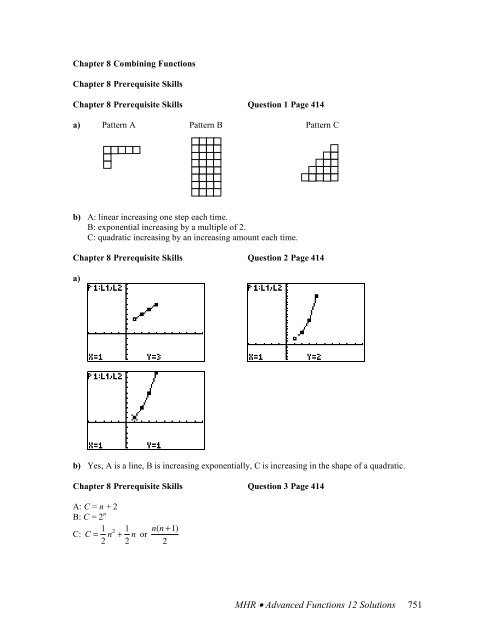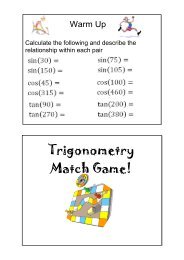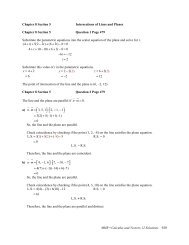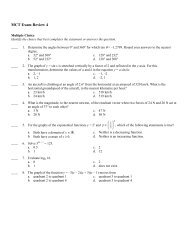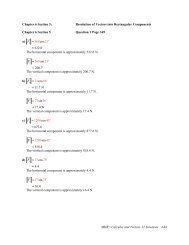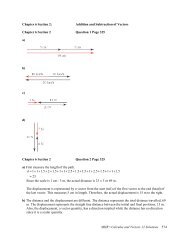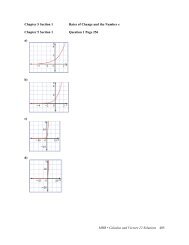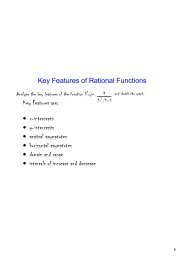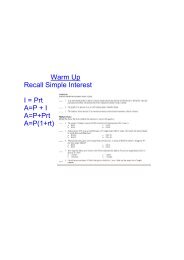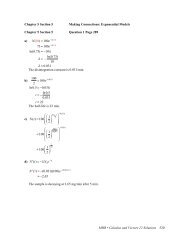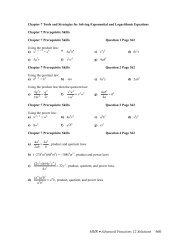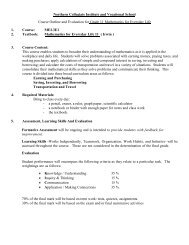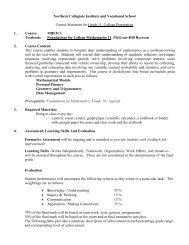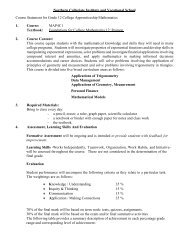MHR • Advanced Functions 12 Solutions 751
MHR • Advanced Functions 12 Solutions 751
MHR • Advanced Functions 12 Solutions 751
Create successful ePaper yourself
Turn your PDF publications into a flip-book with our unique Google optimized e-Paper software.
Chapter 8 Combining <strong>Functions</strong>Chapter 8 Prerequisite SkillsChapter 8 Prerequisite Skills Question 1 Page 414a) Pattern A Pattern B Pattern Cb) A: linear increasing one step each time.B: exponential increasing by a multiple of 2.C: quadratic increasing by an increasing amount each time.Chapter 8 Prerequisite Skills Question 2 Page 414a)b) Yes, A is a line, B is increasing exponentially, C is increasing in the shape of a quadratic.Chapter 8 Prerequisite Skills Question 3 Page 414A: C = n + 2B: C = 2 nC: C = 1 2 n2 + 1 2n orn(n +1)2<strong>MHR</strong> <strong>•</strong> <strong>Advanced</strong> <strong>Functions</strong> <strong>12</strong> <strong>Solutions</strong> <strong>751</strong>
Chapter 8 Prerequisite Skills Question 4 Page 414a) {x ∈ R}, {y ∈ R}b) {x ∈ R}, {y ∈ R, y ≥ 0}c) {x ∈ R}, {y ∈ R}d) {x ∈ R}, {y ∈ R, y ≥ 0}Chapter 8 Prerequisite Skills Question 5 Page 414a) odd, symmetric about the originb) even, symmetric about the y-axisc) odd, symmetric about the origind) even, symmetric about the y-axis<strong>MHR</strong> <strong>•</strong> <strong>Advanced</strong> <strong>Functions</strong> <strong>12</strong> <strong>Solutions</strong> 752
Chapter 8 Prerequisite Skills Question 6 Page 414a)b)f(–x) = –f(x), so the graph is odd.c)f(–x) = f(x), so the graph is even.d)f(–x) = –f(x), so the graph is odd.f(–x) = f(x), so the graph is even.<strong>MHR</strong> <strong>•</strong> <strong>Advanced</strong> <strong>Functions</strong> <strong>12</strong> <strong>Solutions</strong> 753
Chapter 8 Prerequisite Skills Question 7 Page 414a) {x ∈ R, x ≠ 0}, {y ∈ R, y ≠ 0} b) {x ∈ R, x ≠ 4}, {y ∈ R, y ≠ 0}Chapter 8 Prerequisite Skills Question 8 Page 414a) u(x) =x ! 2(x ! 2)(x + 2)u(x) = 1 , x " 2, x " !2x + 2(x ! 3)(x + 2)b) v(x) =x + 2v(x) = x ! 3, x " !2<strong>MHR</strong> <strong>•</strong> <strong>Advanced</strong> <strong>Functions</strong> <strong>12</strong> <strong>Solutions</strong> 754
Chapter 8 Prerequisite Skills Question 9 Page 414a) i) {x ∈ R, x ≠ 2, x ≠ –2}, {y ∈ R, y ≠ 0, y ≠ 1 4 }The domain can be found using the restrictions.To find the range, find domain of the inverse function and the point where the function isdiscontinuous.InverseDiscontinuityx = 1y + 2y + 2 = 1 u(2) = 1x2 + 2y !1 = 1 x ! 2, x " 0= 1 4ii)iii) Vertical asymptote x = –2; horizontal asymptote y = 0!hole: 2, 1 $"# 4%&b) i) {x ∈ R, x ≠ –2}, {y ∈ R, y ≠ –5}The domain can be found using the restrictions.To find the range, find the point where the function is discontinuous.v(!2) = !2 ! 3ii)= !5iii) hole: (–2, –5)<strong>MHR</strong> <strong>•</strong> <strong>Advanced</strong> <strong>Functions</strong> <strong>12</strong> <strong>Solutions</strong> 755
Chapter 8 Prerequisite Skills Question 10 Page 414See question 9 part ii).Chapter 8 Prerequisite Skills Question 11 Page 415Reasons may vary. A sample solution is shown.a) iv; a glider gradually loses altitude and may level off at some pointsb) iii; after one push, the distance of the swing gradually decreasesc) ii; the rocket would go up and then come down after reaching its maximum height.d) i; the distance of the tip never changesChapter 8 Prerequisite Skills Question <strong>12</strong> Page 415Answers may vary. A sample solution is shown.i) 0 s ≤ t ≤ 8 s, –5 cm ≤ d ≤ 5 cmThere are 8 local minima and maxima, so the time is 8 s.The maximum distance the tip of the metronome can travel is 10 cm.ii) 0 s ≤ t ≤ 3 s, 0 m ≤ d ≤ 5 mA toy rocket is launched from a platform that is approximately 4 m high and takesapproximately 3 s to hit the ground.iii) 0 s ≤ t ≤ 10 s, –2 m ≤ d ≤ 2 mThe first push is 2 m forward and the distance decreases each swing. It takes approximately10 s for the swing to go 4 full swings back and forth.iv) 0 s ≤ t ≤ 10 s, 0 m ≤ d ≤ 3 mA toy glider launched from 3 m takes approximately 10 s to reach the ground.<strong>MHR</strong> <strong>•</strong> <strong>Advanced</strong> <strong>Functions</strong> <strong>12</strong> <strong>Solutions</strong> 756
Chapter 8 Prerequisite Skills Question 13 Page 415a) x = y ! 2y = x + 2f !1 (x) = x + 2c) x = y 2 ! 5y 2 = x + 5y = ± x + 5h !1 (x) = ± x + 5, x " !5b) x = 4y + 34y = x ! 3y = x ! 34g !1 (x) = x ! 34d) x = 1y +1y +1 = 1 xy = 1 x !1k !1 (x) = 1 x !1, x " 0Chapter 8 Prerequisite Skills Question 14 Page 415The inverses of parts a), b), and d) are functions, since they pass the vertical line test.functionfunctionnot a functionfunction<strong>MHR</strong> <strong>•</strong> <strong>Advanced</strong> <strong>Functions</strong> <strong>12</strong> <strong>Solutions</strong> 757
Section 1Sums and Differences of <strong>Functions</strong>Chapter 8 Section 1 Question 1 Page 424a) i) Blue ii) Red iii) Yellowb) i) y = 3xx y1 32 63 94 <strong>12</strong>ii) y = x 2 – 1x y1 02 33 84 15iii) y = 2 xx y1 22 43 84 16The tables match the number of tiles shown in each stage.Chapter 8 Section 1 Question 2 Page 424a) y = 3x + x 2 – 1 + 2 xb) i) f (x) = 3x + x 2 !1+ 2 xf (5) = 3(5) + (5) 2 !1+ 2 5= 15+ 25!1+ 32= 71c)ii)f (x) = 3x + x 2 !1+ 2 xf (6) = 3(6) + (6) 2 !1+ 2 6= 18 + 36 !1+ 64= 117Stage 5 Stage 671 tiles 117 tiles<strong>MHR</strong> <strong>•</strong> <strong>Advanced</strong> <strong>Functions</strong> <strong>12</strong> <strong>Solutions</strong> 758
Chapter 8 Section 1 Question 3 Page 424a) i) y = 5x + x + 7y = 6x + 7b) i) y = !2x + 5+ (!x + 9)y = !3x +14ii) y = 5x ! (x + 7)y = 5x ! x ! 7y = 4x ! 7ii) y = !2x + 5! (!x + 9)y = !2x + 5+ x ! 9y = !x ! 4iii) y = x + 7 ! 5xy = !4x + 7iii) y = !x + 9 ! (!2x + 5)y = !x + 9 + 2x ! 5y = x + 4c) i) y = x 2 + 4 +1y = x 2 + 5ii) y = x 2 + 4 !1y = x 2 + 3iii) y = 1! (x 2 + 4)y = 1! x 2 ! 4y = !x 2 ! 3d) i) y = !3x 2 + 4x + 3x ! 7y = !3x 2 + 7x ! 7ii) y = !3x 2 + 4x ! (3x ! 7)y = !3x 2 + 4x ! 3x + 7y = !3x 2 + x + 7iii) y = 3x ! 7 ! (!3x 2 + 4x)y = 3x ! 7 + 3x 2 ! 4xy = 3x 2 ! x ! 7Chapter 8 Section 1 Question 4 Page 424a) h(x) = 4x + 3+ 3x ! 2h(x) = 7x +1h(2) = 7(2) +1h(2) = 15b) j(x) = 4x + 3! (3x ! 2)j(x) = 4x + 3! 3x + 2j(x) = x + 5j(!1) = !1+ 5j(!1) = 4c) k(x) = 3x ! 2 ! (4x + 3)k(x) = 3x ! 2 ! 4x ! 3k(x) = !x ! 5k(0) = !0 ! 5k(0) = !5<strong>MHR</strong> <strong>•</strong> <strong>Advanced</strong> <strong>Functions</strong> <strong>12</strong> <strong>Solutions</strong> 759
Chapter 8 Section 1 Question 5 Page 424a) h(x) = !4x 2 + 5+ 2x ! 3h(x) = !4x 2 + 2x + 2h(!3) = !4(!3) 2 + 2(!3) + 2h(!3) = !4(9) ! 6 + 2h(!3) = !40b) j(x) = !4x 2 + 5! (2x ! 3)j(x) = !4x 2 + 5! 2x + 3j(x) = !4x 2 ! 2x + 8j(0) = !4(0) 2 ! 2(0) + 8j(0) = 8c) k(x) = 2x ! 3! (!4x 2 + 5)k(x) = 2x ! 3+ 4x 2 ! 5k(x) = 4x 2 + 2x ! 8k(3) = 4(3) 2 + 2(3) ! 8k(3) = 4(9) + 6 ! 8k(3) = 34Chapter 8 Section 1 Question 6 Page 424a) {x ∈ R}, {y ∈ R, y = –2}b) {x ∈ R}, {y ∈ R}<strong>MHR</strong> <strong>•</strong> <strong>Advanced</strong> <strong>Functions</strong> <strong>12</strong> <strong>Solutions</strong> 760
Chapter 8 Section 1 Question 7 Page 424a) b)Chapter 8 Section 1 Question 8 Page 425a)b) i) f(x) = 2 x translated 3 units upii) f(x) = 2 x translated 3 units downiii) reflection of f(x) = 2 x in the x-axis and a translation of 3 units up<strong>MHR</strong> <strong>•</strong> <strong>Advanced</strong> <strong>Functions</strong> <strong>12</strong> <strong>Solutions</strong> 761
c) i) {x ∈ R}, {y ∈ R, y > 3}The range is the domain of the inverse.x = 2 y + 3x ! 3 = 2 ylog(x ! 3) = y log 2y =log(x ! 3), x > 3log 2ii) {x ∈ R}, {y ∈ R, y > –3}The range is the domain of the inverse.x = 2 y ! 3x + 3 = 2 ylog(x + 3) = y log 2y =log(x + 3), x > !3log 2iii) {x ∈ R}, {y ∈ R, y < 3}The range is the domain of the inverse.x = 3! 2 y2 y = 3! xy log 2 = log(3! x)y =log(3! x), x < 3log 2Chapter 8 Section 1 Question 9 Page 425a)<strong>MHR</strong> <strong>•</strong> <strong>Advanced</strong> <strong>Functions</strong> <strong>12</strong> <strong>Solutions</strong> 762
) y = sin x + log xx f(x) = sin x g(x) = log x y = sin x + log x0 0 undefined undefined!1 0.1961 1.196<strong>12</strong>π 0 0.4971 0.49713! –1 0.6732 –0.326822π 0 0.7982 0.7982c) y = sin x – log xx f(x) = sin x g(x) = log x y = sin x – log x0 0 undefined undefined!1 0.1961 0.80392π 0 0.4971 –0.49713! –1 0.6732 –1.673222π 0 0.7982 –0.7982d) see parts b) and c)<strong>MHR</strong> <strong>•</strong> <strong>Advanced</strong> <strong>Functions</strong> <strong>12</strong> <strong>Solutions</strong> 763
Chapter 8 Section 1 Question 10 Page 425a) i) C = <strong>12</strong>0 + h ii) R = 2.5hb) Y 1 = Cost Y 2 = Revenuec) The break-even point is the point at which the revenue and cost are equal. When the vendorhas sold 80 hotdogs, the cost and the revenue are both equal to $200.00.<strong>MHR</strong> <strong>•</strong> <strong>Advanced</strong> <strong>Functions</strong> <strong>12</strong> <strong>Solutions</strong> 764
d) P(h) = 2.5h ! (<strong>12</strong>0 + h)P(h) = 2.5h !<strong>12</strong>0 ! hP(h) = 1.5h !<strong>12</strong>0e) C(h): {h ∈ Z, 0 ≤ h ≤ 250}, {C ∈ R, <strong>12</strong>0 ≤ C ≤ 370}R(h): {h ∈ Z, 0 ≤ h ≤ 250}, {R ∈ R, 0 ≤ R ≤ 625}P(h): {h ∈ Z, 0 ≤ h ≤ 250}, {P ∈ R, –<strong>12</strong>0 ≤ P ≤ 255}f) P(250) = 1.5(250) !<strong>12</strong>0= 255The maximum daily profit is $255.<strong>MHR</strong> <strong>•</strong> <strong>Advanced</strong> <strong>Functions</strong> <strong>12</strong> <strong>Solutions</strong> 765
Chapter 8 Section 1 Question 11 Page 425a) i) C 1 = 100 + hC 2 = <strong>12</strong>0 + 0.9hC 1 = 100 + h has the most favourable effect on the break-even point since the vendor willbreak-even after selling less hotdogs.When the vendor has sold approximately 67 hotdogs, the cost and the revenue are bothequal to approximately $166.67.<strong>MHR</strong> <strong>•</strong> <strong>Advanced</strong> <strong>Functions</strong> <strong>12</strong> <strong>Solutions</strong> 766
ii) Method 1:C 1 = 100 + hC 2 = <strong>12</strong>0 + 0.9hC 2 = <strong>12</strong>0 + 0.9h has the most favourable effect on the maximum profit. The potentialdaily profit becomes $280.Method 2:C 1Maximum daily profit = 2.5h – (100 + h)= 2.5(250) – (100 + 250)= 625 – 350= 275C 2Maximum daily profit = 2.5h – (<strong>12</strong>0 + 0.9h)= 2.5(250) – [<strong>12</strong>0 + 0.9(250)]= 625 – (<strong>12</strong>0 + 225)= 280b) Answers may vary. A sample solution is shown.If you always sell a lot, choose C 2 (reduce the variable cost) since it has a higher maximumvalue, but if you often sell around 70, choose C 1 (reduce the fixed cost) because it has a lowerbreak-even point.<strong>MHR</strong> <strong>•</strong> <strong>Advanced</strong> <strong>Functions</strong> <strong>12</strong> <strong>Solutions</strong> 767
Chapter 8 Section 1 Question <strong>12</strong> Page 425a) AC DCb)c) From the graph, the domain and range are: {t ∈ R}, {y ∈ R, 5 ≤ y ≤ 25}d) i) 5 ii) 25 iii)5+ 252= 15<strong>MHR</strong> <strong>•</strong> <strong>Advanced</strong> <strong>Functions</strong> <strong>12</strong> <strong>Solutions</strong> 768
Chapter 8 Section 1 Question 13 Page 426a) The function and the total tiles pattern are the same.b)c)d)T(x) seems to converge with f(x) = 2 x .e) Answers may vary. A sample solution is shown.The rate of change of the exponential function is continuously increasing at a greater rate thanthe other component functions.<strong>MHR</strong> <strong>•</strong> <strong>Advanced</strong> <strong>Functions</strong> <strong>12</strong> <strong>Solutions</strong> 769
Chapter 8 Section 1 Question 14 Page 426a) Yes, f(x) + g(x) = g(x) + f(x) is true for all functions f(x) and g(x) using the commutativeproperty.Examples may vary. A sample solution is shown.Example 1: Example 2:f(x) = x + 7, g(x) = 5x – 3f(x) = a, g(x) = bf (x) + g(x) = x + 7 + 5x ! 3f (x) + g(x) = a + b= 6x + 4g(x) + f (x) = 5x ! 3+ x + 7Example 3:= 6x + 4f (x) = x 2 ! 6x + 2, g(x) = 1x +1 ! 5f (x) + g(x) = x 2 ! 6x + 2 + 1x +1 ! 5= x 2 ! 6x + 1x +1 ! 3g(x) + f (x) = 1x +1 ! 5+ x2 ! 6x + 2= x 2 ! 6x + 1x +1 ! 3b) No, f(x) – g(x) = g(x) – f(x) is not true for all functions f(x) and g(x).Examples may vary. A sample solution is shown.g(x) + f (x) = b + a= a + bExample 1: Example 2:f(x) = –2x + 3, g(x) = 5x – 2f(x) = a, g(x) = bf (x) ! g(x) = !2x + 3! (5x ! 2)f (x) ! g(x) = a ! b= !2x + 3! 5x + 2= !7x + 5g(x) ! f (x) = 5x ! 2 ! (!2x + 3)= 5x ! 2 + 2x ! 3= 7x ! 5g(x) ! f (x) = b ! a= !a + b<strong>MHR</strong> <strong>•</strong> <strong>Advanced</strong> <strong>Functions</strong> <strong>12</strong> <strong>Solutions</strong> 770
Example 3:f(x) = x 3 – 2x 2 + 6, g(x) = 2x 3 – 5x – 3f (x) ! g(x) = x 3 ! 2x 2 + 6 ! (2x 3 ! 5x ! 3)= x 3 ! 2x 2 + 6 ! 2x 3 + 5x + 3= !x 3 ! 2x 2 + 5x + 9g(x) ! f (x) = 2x 3 ! 5x ! 3! (x 3 ! 2x 2 + 6)= 2x 3 ! 5x ! 3! x 3 + 2x 2 ! 6= x 3 + 2x 2 ! 5x ! 9c) The commutative property holds true for the sum of two functions, but not the difference oftwo functions.Chapter 8 Section 1 Question 15 Page 426a)b)c)f(x) = g(x), when c = 0<strong>MHR</strong> <strong>•</strong> <strong>Advanced</strong> <strong>Functions</strong> <strong>12</strong> <strong>Solutions</strong> 771
d)e) {x ∈ R}, {y ∈ R, –2 ≤ y ≤ 2}f) i) shifted to the right and the amplitude is multiplied by 2ii) horizontal lineiii) same as when c = 0g) i) {x ∈ R}, {y ∈ R, – 2 ≤ y ≤ 2 }ii) {x ∈ R}, {y = 0}iii) {x ∈ R}, {y ∈ R, –2 ≤ y ≤ 2}<strong>MHR</strong> <strong>•</strong> <strong>Advanced</strong> <strong>Functions</strong> <strong>12</strong> <strong>Solutions</strong> 772
h) Answers may vary. A sample solution is shown.When two equal waves meet crest to crest or trough to trough, the magnitude is doubled.When two equal waves meet crest to trough, the waves cancel each other out.Chapter 8 Section 1 Question 16 Page 427a) y = !g(x)b)= !(x + 2)= !x ! 2c) y = f (x) + "#!g(x)$%y = x + 5+ [!(x + 2)]y = 3d)<strong>MHR</strong> <strong>•</strong> <strong>Advanced</strong> <strong>Functions</strong> <strong>12</strong> <strong>Solutions</strong> 773
e) y = f (x) ! g(x)y = (x + 5) ! (x + 2)y = x + 5! x ! 2y = 3The results are the same.f) Answers may vary. A sample solution is shown.Subtracting the functions is the same as adding the opposite.Chapter 8 Section 1 Question 17 Page 427f(x) = a, g(x) = bf (x) ! g(x) = a ! bf (x) + "#!g(x)$% = a + (!b)= a ! bf (x) ! g(x) = f (x) + "#!g(x)$%Chapter 8 Section 1 Question 18 Page 427a) Fixed costs = <strong>12</strong> 000 + 3000 + 5000= 20 000The fixed costs are $20 000. They are not affected by the number of games.<strong>MHR</strong> <strong>•</strong> <strong>Advanced</strong> <strong>Functions</strong> <strong>12</strong> <strong>Solutions</strong> 774
) Variable costs = 6x + 9x= 15xThe total variable costs are $15/game. The cost increases per game at a constant rate.c) C = 20 000 + 15xThis function represents the total operating costs.d) The revenue is increasing at a constant rate.R = 20xe)The break-even point is the point at which the revenue and cost are equal (the profitequals zero).When 4000 games are sold, the cost and revenue equal $80 000.<strong>MHR</strong> <strong>•</strong> <strong>Advanced</strong> <strong>Functions</strong> <strong>12</strong> <strong>Solutions</strong> 775
f) Y 5= 20x ! (20 000 +15x)= 20x ! 20 000 !15x= 5x ! 20 000This function represents the profit.g) i) To the left of the x-intercept is a loss in profit.ii) At the x-intercept is the break-even point.iii) To the right of the x-intercept is a profit.h) Answers may vary. A sample solution is shown.i) The break-even point would move to the left and thus be reached sooner.ii) The break-even point would move to the right and thus be reached later.Assuming fixed costs stay the same.Chapter 8 Section 1 Question 19 Page 427<strong>Solutions</strong> to Achievement Check questions are provided in the Teacher’s Resource.Chapter 8 Section 1 Question 20 Page 428a)b), c)0<strong>MHR</strong> <strong>•</strong> <strong>Advanced</strong> <strong>Functions</strong> <strong>12</strong> <strong>Solutions</strong> 776
d)There appear to be an infinite number of intersection points.e) g(x) intersects h(x) at the point of inflection due to the variable vertical translation.Chapter 8 Section 1 Question 21 Page 428a)b), c)d)There appear to be an infinite number of intersection points.e) g(x) intersects h(x) at the point of inflection due to the variable vertical translation.<strong>MHR</strong> <strong>•</strong> <strong>Advanced</strong> <strong>Functions</strong> <strong>12</strong> <strong>Solutions</strong> 777
Chapter 8 Section 1 Question 22 Page 428Yes, the superposition principle can be extended to multiplication or division of two functions.Answers may vary. A sample solution is shown.Example 1:f (x) = 2x, g(x) = 3h(x) = f (x) ! g(x)= 6xx f(x) = 2x g(x) = 3 h(x) = 6x–2 –4 3 –<strong>12</strong>–1 –2 3 –60 0 3 01 2 3 62 4 3 <strong>12</strong>Example 2:f (x) = <strong>12</strong>x 2 , g(x) = 4xh(x) = f (x)g(x) , g(x) ! 0h(x) = <strong>12</strong>x24x= 3x, x ! 0x f(x) = <strong>12</strong>x 2 g(x) = 4x h(x) = 3x–2 28 –8 –6–1 <strong>12</strong> –4 –30 0 0 01 <strong>12</strong> 4 32 48 8 6<strong>MHR</strong> <strong>•</strong> <strong>Advanced</strong> <strong>Functions</strong> <strong>12</strong> <strong>Solutions</strong> 778
Chapter 8 Section 1 Question 23 Page 428The sum of two even functions is even.Examples will vary. A sample solution is shown.Example 1:f (x) = x 2 , g(x) = x 4h(x) = f (x) + g(x)= x 4 + x 2f (!x) = (!x) 2 g(!x) = (!x) 4= x 2 = x 4f (!x) = f (x) evenh(!x) = (!x) 4 + (!x) 2= x 4 + x 2h(!x) = h(x) eveng(!x) = g(x) evenExample 2:y = cos xy = cos 2 xy = cos 2 x + cos xThe functions are all even.<strong>MHR</strong> <strong>•</strong> <strong>Advanced</strong> <strong>Functions</strong> <strong>12</strong> <strong>Solutions</strong> 779
Example 3:y = 1 x y = ! 1 $2 "#2x %&2y = 1 x + ! 1 $2 "#2x %&2The functions are all even.Chapter 8 Section 1 Question 24 Page 428Bf (x +1) ! f (x) = 6x ! 8let x = 1f (1+1) ! f (1) = 6(1) ! 8f (2) ! f (1) = !2f (2) ! 26 = !2 substitute f (1) = 26f (2) = 26 ! 2f (2) = 24<strong>MHR</strong> <strong>•</strong> <strong>Advanced</strong> <strong>Functions</strong> <strong>12</strong> <strong>Solutions</strong> 780
Chapter 8 Section 1 Question 25 Page 428DMethod 1:find the limit as x ! ±"2xx + 5 x3xx + 8 x2 + 5= x3+ 8 , as x ! ±", 5 x and 8 x approach 0x= 2 3Method 2:Suppose 2x + 53x + 8 = 2 33(2x + 5) = 2(3x + 8)6x +15 = 6x +16but 15 ! 16There is no solution.Chapter 8 Section 1 Question 26 Page 428x = 14 ! y , 1 x = 4 ! y1x + 4x + y ! yx !1 = (4 ! y) + 4 " 1 %#$ 4 ! y &' + y ! y " 1 %#$ 4 ! y &' !1= 4 !1! y + y + 44 ! y ! y4 ! y= 3+ 4 ! y4 ! y= 3+1= 4<strong>MHR</strong> <strong>•</strong> <strong>Advanced</strong> <strong>Functions</strong> <strong>12</strong> <strong>Solutions</strong> 781
Chapter 8 Section 1 Question 27 Page 428( Ax !1)(x + A) = 0Ax 2 + Ax ! x ! A = 0x = 1 A or x = ! A! A = CA = !CIf the roots are negative reciprocals, then A = –C.( Ax +1)(x + A) = 0Ax 2 + Ax + x + A = 0x = 1 A or x = AA = CIf the roots are reciprocals, then A = C.<strong>MHR</strong> <strong>•</strong> <strong>Advanced</strong> <strong>Functions</strong> <strong>12</strong> <strong>Solutions</strong> 782
Section 2Products and Quotients of <strong>Functions</strong>Chapter 8 Section 2 Question 1 Page 435a) even: A and B since they are both even functions;odd: A and C since A is even and C is odd, B and C since B is even and C is odd.b) Yes, two combinations multiply to form an odd function.Chapter 8 Section 2 Question 2 Page 435The product of all three functions is odd since there are two even functions and one odd function.Chapter 8 Section 2 Question 3 Page 435A: y = |x|; B: y = cos x; C: y = x 3A × B = evenA × C = oddB × C = oddA × B × C<strong>MHR</strong> <strong>•</strong> <strong>Advanced</strong> <strong>Functions</strong> <strong>12</strong> <strong>Solutions</strong> 783
Chapter 8 Section 2 Question 4 Page 435a) y = (x ! 2)(x 2 ! 4)y = x 3 ! 2x 2 ! 4x + 8{x ∈ R}, {y ∈ R}b) y = x ! 2x 2 ! 4x ! 2y =(x ! 2)(x + 2)y = 1 , x " 2, x " !2x + 2There is a hole when x = 2.y = <strong>12</strong> + 2= 1 4!2, 1 $"# 4%&There is a vertical asymptote at x = –2 and a horizontal asymptote at y = 0.The domain and range; {x ∈ R, x ≠ 2, x ≠ –2}, {y ∈ R, y ≠ 1 4 , y ≠ 0}<strong>MHR</strong> <strong>•</strong> <strong>Advanced</strong> <strong>Functions</strong> <strong>12</strong> <strong>Solutions</strong> 784
c) y = x2 ! 4x ! 2(x ! 2)(x + 2)y =(x ! 2)y = x + 2, x " 2There is a hole when x = 2.y = 2 + 2= 4(2, 4)The domain and range; {x ∈ R, x ≠ 2}, {y ∈ R, y ≠ 4}Chapter 8 Section 2 Question 5 Page 436a) y = 0.95 x cos x, {x ∈ R}, {y ∈ R} b) y = cos x , {x ∈ R}, {y ∈ R}x0.95<strong>MHR</strong> <strong>•</strong> <strong>Advanced</strong> <strong>Functions</strong> <strong>12</strong> <strong>Solutions</strong> 785
c) y = 0.95xcos x , cos x ! 0(2n +1)!The vertical asymptotes are x = , n ∈ Z and the horizontal asymptote is y = 0.2(2n +1)!The domain and range; , {x ∈ R, x ≠ , n ∈ Z}, {y ∈ R, y ≠ 0}2Chapter 8 Section 2 Question 6 Page 436a) Both functions are exponential, with fish increasing P(t) and food decreasing F(t).P(t)F(t)b) P(t): {t ∈ R}, {P ∈ R, P ≥ 0}F(t): {t ∈ R}, {F ∈ R, F ≥ 0}c)The point of intersection is approximately (9.11, 467.88).In 9.11 years, the number of fish and the amount fish food both equal 467.88.<strong>MHR</strong> <strong>•</strong> <strong>Advanced</strong> <strong>Functions</strong> <strong>12</strong> <strong>Solutions</strong> 786
d) Answers may vary. A sample solution is shown.This function is the amount of fish food minus the number of fish. When the function ispositive, there is a surplus of food. When the function is negative, there is not enough food.e)The t-intercept is approximately 9.11. It is the same as the crisis point.f) Answers may vary. A sample solution is shown.P(t) should start to decrease since the amount of food is decreasing.The graphs might level off at the crisis point.Chapter 8 Section 2 Question 7 Page 436a) Answers may vary. A sample solution is shown.This function represents the ratio of food to fish. If the function is greater than one, there ismore than enough food. The graph is decreasing.b) The coordinates at the crisis point are approximately (9.11, 1). This means that after9.11 years, the amount of food is equal to the number of the fish.c) Before the crisis point there is plenty of food. At the crisis point there is exactly enough food.After the crisis point there is not enough food.<strong>MHR</strong> <strong>•</strong> <strong>Advanced</strong> <strong>Functions</strong> <strong>12</strong> <strong>Solutions</strong> 787
Chapter 8 Section 2 Question 8 Page 436a) The shape of the graph is a semi-circle. The graph is even since it is symmetric about the y-axis.b) The graph of g(x) is odd since it is symmetric about the origin.c) Predictions will vary. Sample prediction: The graph will be sinusoidal and have limiteddomain and range. It will be odd.d)Domain: {x ∈ R, –5 ≤ x ≤ 5}; Range: {y ∈ R, –4.76 ≤ x ≤ 4.76}Estimate since the maximum occurs at an unknown x-value.<strong>MHR</strong> <strong>•</strong> <strong>Advanced</strong> <strong>Functions</strong> <strong>12</strong> <strong>Solutions</strong> 788
Chapter 8 Section 2 Question 9 Page 436a) y =25! x 2 > 025 > x 2sin x25! x 2!5 < x < 5The function is odd since it is symmetric about the origin.Domain: {x ∈ R, –5 < x < 5}; Range: {y ∈ R}25! x2b) y = , sin x " 0 , x ≠ –π, x ≠ 0, x ≠ πsin xThe function is odd since it is symmetric about the origin.Domain: {x ∈ R, –5 ≤ x ≤ 5, x ≠ –π, x ≠ 0, x ≠ π}; Range: {y ∈ R}<strong>MHR</strong> <strong>•</strong> <strong>Advanced</strong> <strong>Functions</strong> <strong>12</strong> <strong>Solutions</strong> 789
Chapter 8 Section 2 Question 10 Page 437a) P(t) is exponential and increasing, while F(t) is linear and increasing.b) y = 8 + 0.04t – 6(1.02) tAnswers may vary. A sample solution is shown.In 2008, there is a surplus, since the function is positive.After 2019, there will be a food shortage.Answers may vary. A sample solution is shown.After about 19 years there will be a food shortage.c) (0, 2); In 2000, the maximum is 2, which is the amount of the surplus of food.<strong>MHR</strong> <strong>•</strong> <strong>Advanced</strong> <strong>Functions</strong> <strong>12</strong> <strong>Solutions</strong> 790
Chapter 8 Section 2 Question 11 Page 437a) The function is decreasing.b) The food production is a maximum in 2000. This is the same as in 10c).c) When F(t)F(t)> 1, there is a surplus of food. When < 1, there is a shortage of food. ForP(t) P(t)Terra, there is a surplus of food before 2019 and a shortage of food after 2019.Chapter 8 Section 2 Question <strong>12</strong> Page 437Answers may vary. A sample solution is shown.Trade the surplus now to save for the future shortage or to improve the food production plan.<strong>MHR</strong> <strong>•</strong> <strong>Advanced</strong> <strong>Functions</strong> <strong>12</strong> <strong>Solutions</strong> 791
Chapter 8 Section 2 Question 13 Page 437a) p Ask (t) is periodic; {t ∈ R, t ≥ 0},{p Ask ∈ R, 0.05 ≤ p Ask ≤ 0.95}p Yes (t) is quadratic, increasing and then decreasing;{t ∈ R, 0 ≤ t ≤ 7},{p Yes ∈ R, 0 ≤ p Yes ≤ 0.98}p Ask (t)p Yes (t)b)(4n ! 3)"2days after the danceAt the maximum values of p Ask (t), which occur at ! 2 , 5! 2 , 9! 2,.... days after the dance.Carlos is most likely to ask Keiko to dance approximately 1.6, 7.9, 14.1, …. days after thedance.c) At the maximum value of p Yes (t), which occurs approximately 3.5 days after the dance.d) Answers may vary. A sample solution is shown.The zeros of this graph are the points of intersection of the graphs p Yes (t) and p Ask (t)These are the points at which the probabilities are equally likely.Above the x-axis, Carlos is more likely to ask than Keiko is likely to say yes.Below the x-axis, Carlos is less likely to ask than Keiko is likely to say yes.<strong>MHR</strong> <strong>•</strong> <strong>Advanced</strong> <strong>Functions</strong> <strong>12</strong> <strong>Solutions</strong> 792
Chapter 8 Section 2 Question 14 Page 437a) y = (0.45sint + 0.5) "#!0.08t(t ! 7) $%y = (0.45sint + 0.5)(!0.08t 2 + 0.56t)y = !0.036t 2 sint + 0.252t sint ! 0.04t 2 + 0.28tb)c)There is approximately a 73% chance of Carlos and Keiko agreeing to date 2.1 days after thedance.Carlos has no chance of dating Keiko after 7 days.d) Answers may vary. A sample solution is shown.Force Carlos to ask Keiko out after 3.5 days, when she is most likely to say yes.<strong>MHR</strong> <strong>•</strong> <strong>Advanced</strong> <strong>Functions</strong> <strong>12</strong> <strong>Solutions</strong> 793
Chapter 8 Section 2 Question 15 Page 438Yes, the product of functions does commute.Examples may vary. A sample solution is shown.f (x) = 5x ! 2, g(x) = !3x +1f (x)g(x) = (5x ! 2)(!3x +1)= !15x 2 +11x ! 2g(x) f (x) = (!3x +1)(5x ! 2)= !15x 2 +11x ! 2f (x)g(x) = g(x) f (x)f (x) = a, g(x) = bf (x)g(x) = a ! bg(x) f (x) = b ! aa ! b = b ! a, a, b "RChapter 8 Section 2 Question 16 Page 438No, the division of two functions does not commute.Examples may vary. A sample solution is shown.f (x) = x 2 ! 9, g(x) = x + 3f (x)g(x) = x2 ! 9x + 3(x ! 3)(x + 3)=x + 3= x ! 3, x " !3g(x)f (x) = x + 3x 2 ! 9x + 3=(x ! 3)(x + 3)= 1x ! 3 , x " !3, x " 3f (x)g(x) " g(x)f (x)<strong>MHR</strong> <strong>•</strong> <strong>Advanced</strong> <strong>Functions</strong> <strong>12</strong> <strong>Solutions</strong> 794
Chapter 8 Section 2 Question 17 Page 438x-intercept 0, y-intercept 0horizontal asymptote y = 0For x < 0 the function is negative and increasing.For 0 < x < 4.33 the function is positive and increasing.For x > 4.33 the function is positive and decreasing.as x ! ", y ! 0as x ! #", y ! #"Domain: {x ∈ R}; Range:{y ∈ R, y ≤ 4.04}Chapter 8 Section 2 Question 18 Page 438<strong>Solutions</strong> to Achievement Check questions are provided in the Teacher’s Resource.Chapter 8 Section 2 Question 19 Page 438a), c) i) The square of f(x) is even, since the product of two even functions is even.Examples may vary. A sample solution is shown.f (x) = x 2k , k !Z is an even function2"# f (x) $% = " x2k$# %2= x 4k , k !Z is an even functionf (x) = cos x is an even function!" f (x)#$2= cos 2 x is an even function<strong>MHR</strong> <strong>•</strong> <strong>Advanced</strong> <strong>Functions</strong> <strong>12</strong> <strong>Solutions</strong> 795
ii) The cube of f(x) is even, since the product of three even functions is even.Examples may vary. A sample solution is shown.f (x) = x 2k , k !Z is an even function3"# f (x) $% = " x2k$# %3= x 6k , k !Z is an even functionf (x) = 1 , is an even function2x3 1!" f (x)#$ = , is an even function6xa), c)iii) The nth power of f(x) is even, since the product of n even functions is even.Examples may vary. A sample solution is shown."#f (x) = x 2k , k !Z is an even functionf (x) $%n= " x2k#= x kn$%n( ) 2 , n, k !Z is an even functionb), c) i) The square of f(x) is even, since the product of two odd functions is even.Examples may vary. A sample solution is shown.f (x) = x 2k +1 , k !Z is an odd function2"# f (x) $% = " x2k +1$# %2= x 4k +2 , k !Z is an even functionf (x) = sin x is and odd function!" f (x)#$2= sin 2 x is an even function<strong>MHR</strong> <strong>•</strong> <strong>Advanced</strong> <strong>Functions</strong> <strong>12</strong> <strong>Solutions</strong> 796
), c)ii) The cube of f(x) is odd, since the product of three odd functions is odd.Examples may vary. A sample solution is shown.f (x) = x 2k +1 , k !Z is an odd function3"# f (x) $% = " x2k +1$# %3= x 6k +3 , k !Z is an odd functionf (x) = x 3 is an odd function!" f (x)#$3= x 9 is and odd functionb) iii) [f(x)] n is even if n is even and [f(x)] n is odd when n is odd.Examples may vary. A sample solution is shown."#f (x) = x 2k +1 , k !Z is an odd functionf (x) $%n= " x2k +1#$%= x 2nk + n , k, n !ZnIf n is odd, then f (x) is oddIf n is even, then f (x) is even<strong>MHR</strong> <strong>•</strong> <strong>Advanced</strong> <strong>Functions</strong> <strong>12</strong> <strong>Solutions</strong> 797
Chapter 8 Section 2 Question 20 Page 438a) period = 2! 2or simply πL =g4! 2 T 2 ,where L is the length of the pendulum, g = 9.8 is the force of gravity,T is the periodL = 9.84! 2 (! 2 )= 2.45The length of the pendulum is 2.45 m.b) original functioni) Air resistance reduced ii) pendulum lengthenedThe amplitude is greater.The period is longer.Chapter 8 Section 2 Question 21 Page 438x + xy = <strong>12</strong>100xyx !100 = 8100x + xy = <strong>12</strong>00 100x ! xy = 800100x + xy = <strong>12</strong>00100x ! xy = 800200x = 2000x = 10<strong>MHR</strong> <strong>•</strong> <strong>Advanced</strong> <strong>Functions</strong> <strong>12</strong> <strong>Solutions</strong> 798
Chapter 8 Section 2 Question 22 Page 438l 1 7 15l 2 4 xl 1! l 3= 7l 3 l 4l 1! l 4= 15 " l 4= 15l 1l 2! l 3= 4 " l 2= 4 l 3l 2! l 4= xx = 4 l 3! 15l 1substitute l 2= 4 l 3and l 4= 15l 1x = 60l 3! l 1x = 607Chapter 8 Section 2 Question 23 Page 438f (xy) = f (x)ylet x = 500, y = 6 5"f (600) = f 500 ! 6 %#$ 5&'= f (500)65= 3 65= 3! 5 6= 5 2<strong>MHR</strong> <strong>•</strong> <strong>Advanced</strong> <strong>Functions</strong> <strong>12</strong> <strong>Solutions</strong> 799
Chapter 8 Section 2 Question 24 Page 438V c= 9 !11! 38.5 Volume of the container= 3811.53811.5 = 1.1V wV w= 3465h w= 34659 !11h w= 35Volume of the waterHeight of the waterThe water should be filled to a depth of 35 cm so the ice does not rise above the top of thecontainer.<strong>MHR</strong> <strong>•</strong> <strong>Advanced</strong> <strong>Functions</strong> <strong>12</strong> <strong>Solutions</strong> 800
Section 3Composite <strong>Functions</strong>Chapter 8 Section 3 Question 1 Page 447a) y = !(x + 3) 2 + 2y = !(x 2 + 6x + 9) + 2y = !x 2 ! 6x ! 7b) y = "#(!x + 2) + 3$%y = (!x + 5) 2y = x 2 !10x + 252c) y = !(!x + 2) + 2y = xd) y = !"(x + 3) 2 + 3#$2y = (x 2 + 6x + 9 + 3) 2y = (x 2 + 6x +<strong>12</strong>) 2y = x 4 + 6x 3 +<strong>12</strong>x 2 + 6x 3 + 36x 2 + 72x +<strong>12</strong>x 2 + 72x +144y = x 4 +<strong>12</strong>x 3 + 60x 2 +144x +144e) x = ! y + 2y = 2 ! xf !1f !1 (x) = 2 ! x( f (x)) = 2 ! (!x + 2)= xChapter 8 Section 3 Questions 2 and 3 Page 447a) {x ∈ R}, {y ∈ R, y ≤ 2} b) {x ∈ R}, {y ∈ R, y ≥ 0}c) {x ∈ R}, {y ∈ R} d) {x ∈ R}, {y ∈ R, y ≥ 9}<strong>MHR</strong> <strong>•</strong> <strong>Advanced</strong> <strong>Functions</strong> <strong>12</strong> <strong>Solutions</strong> 801
e) {x ∈ R}, {y ∈ R}Chapter 8 Section 3 Question 4 Page 447a) g( f (x)) =1x 2 + 2x ! 41=x 2 + 2x ! 31g( f (0)) =0 2 + 2(0) ! 3( ) +11b) g(!2) =!2 +1= !1f (g(!2)) = (!1) 2 + 2(!1) ! 4= 1! 2 ! 4= !5= ! 1 31c) g( f (x)) =x 2 + 2x ! 31g( f (1)) =1 2 + 2(1) ! 3= 1 0 , undefined1g( f (!3)) =(!3) 2 + 2(!3) ! 3= 1 0 , undefined<strong>MHR</strong> <strong>•</strong> <strong>Advanced</strong> <strong>Functions</strong> <strong>12</strong> <strong>Solutions</strong> 802
Chapter 8 Section 3 Question 5 Page 447a) B(t) is decreasing at a constant rate.b) B(0) = 40 ! 0.5(0)= 40The Blue party has 40% popularity at the beginning of the campaign.c) From the equation B(t) = 40 – 0.5t, the slope is –0.5.The popularity of the Blue party is decreasing by 0.5%/day.d) Answers may vary. A sample solution is shown.No, you cannot tell if these are the only two parties in the election. The Blue party starts offwith 40% and the Red party with 20%, there is a good possibility that there are more than twoparties. Knowing the percent of undecided voters would help.Chapter 8 Section 3 Question 6 Page 447a) R(t) = 20 + 0.75"# 40 ! (40 ! 0.5t) $%R(t) = 20 + 0.75(0.5t)R(t) = 20 + 0.375tThe graph is increasing at a constant rate.b) R(0) = 20 + 0.375(0)= 20The Red party has 20% popularity at the beginning of the campaign.c) From the equation R(t) = 20 + 0.375t, the slope is 0.375.The popularity of the Red party is increasing by 0.375%/day.<strong>MHR</strong> <strong>•</strong> <strong>Advanced</strong> <strong>Functions</strong> <strong>12</strong> <strong>Solutions</strong> 803
d)Answers may vary. A sample solution is shown.If the election is held before 22.9 days, the Blue party will win. If the election is held after22.9 days, the Red party will win. 22.9 days is approximately when the two functionsintersect.Chapter 8 Section 3 Question 7 Page 447a)V(t) represents the voters not decided on the Red or Blue parties. The graph is increasing at aconstant rate.b) See graphs in part a).Answers may vary. A sample solution is shown.The third party will win if the election is held before 80 days. At 80 days, both the red partyand the third party have 50% of the vote, while the Blue Party has 0% of the vote.c) Answers may vary. A sample solution is shown.If there were a fourth party, it would split the popularity in V(t), and we could not tell whowill win at any point.<strong>MHR</strong> <strong>•</strong> <strong>Advanced</strong> <strong>Functions</strong> <strong>12</strong> <strong>Solutions</strong> 804
Chapter 8 Section 3 Question 8 Page 447No, f(g(x)) = g(f(x)) is not true for all functions f(x) and g(x).Examples may vary. A sample solution is shown.f(x) = x + 1, g(x) = 2xf (g(x)) = 2x +1g( f (x)) = 2(x +1)= 2x + 2f (g(x)) ! g( f (x))Chapter 8 Section 3 Question 9 Page 447a) x = y 31y = x3"1%b) f ( f !1 (x)) = x3$ '# &= x3c) f !1 ( f (x)) = ( x ) 13 3= xd) The answers are the same.e) f ( f !1 (3)) = 3 f ( f !1 (5)) = 5 f ( f !1 (!1)) = !1f ( f !1 (x)) = x for all values of x.<strong>MHR</strong> <strong>•</strong> <strong>Advanced</strong> <strong>Functions</strong> <strong>12</strong> <strong>Solutions</strong> 805
Chapter 8 Section 3 Question 10 Page 448Answers may vary. A sample solution is shown.Let f (x) = 1x + 2x = 1y + 2y + 2 = 1 xg(x) = x ! 9x = y ! 9y = x + 9y = 1 x ! 2 g !1 (x) = x + 9f !1 (x) = 1 x ! 2f( f !1 (x)) =1" 1#$ x ! 2 %&' + 2g ( g !1 (x)) = x + 9 ! 9= x= 1 1x= xf !1( f (x)) =11x + 2! 2= x + 2 ! 2= xg !1( g(x) ) = x ! 9 + 9= xYes.f ( f !1 (x)) = x for all functions whose inverses are functionsf !1 ( f (x)) = x for all functions whose inverses are functions<strong>MHR</strong> <strong>•</strong> <strong>Advanced</strong> <strong>Functions</strong> <strong>12</strong> <strong>Solutions</strong> 806
Chapter 8 Section 3 Question 11 Page 448a), b)y = sin 2 xc) Yes, the function in part a) is periodic, since it repeats itself from left to right.d) {x ∈ R}, {y ∈ R, 0 ≤ y ≤ 1}Chapter 8 Section 3 Question <strong>12</strong> Page 448a) y = sin 3 xThe function is periodic since it repeats itself.{x ∈ R}, {y ∈ R, –1 ≤ y ≤ 1}b) Answers may vary. A sample solution is shown.The functions are both periodic and have a maximum value of 1. The functions differ in theirminimum values (0 versus –1) and period (π versus 2π). One function is even, while the otheris odd.<strong>MHR</strong> <strong>•</strong> <strong>Advanced</strong> <strong>Functions</strong> <strong>12</strong> <strong>Solutions</strong> 807
Chapter 8 Section 3 Question 13 Page 448"a) C(t) = 1.54$<strong>12</strong>.1! 2#t52%' + 58.55&C(t) = 18.634 ! 252 + 58.55b)tc) Method 1:It will take approximately 60 years to reach 100 ppm.Method 2:52100 = 18.634 ! 2 + 58.5541.45 = 18.634 ! 2log 41.4518.634 = log 2 t52log 41.4518.634 = t52 log 2tlog 41.4552 = 18.634log 2t =tt5252 log 41.4518.634log 2&= 60.0<strong>MHR</strong> <strong>•</strong> <strong>Advanced</strong> <strong>Functions</strong> <strong>12</strong> <strong>Solutions</strong> 808
Chapter 8 Section 3 Question 14 Page 448Answers may vary. A sample solution is shown.Let f (x) = x + 3 and g(x) = 2x ! 5x = y + 3 x = 2y ! 5y = x ! 3 2y = x + 5f !1 (x) = x ! 3 y = x + 52g !1 (x) = x + 52( f o g) !1 (x) = "# f (g(x)) $%g !1f !1!1= "# 2x ! 5+ 3$%= "# 2x ! 2$%x = 2y ! 22y = x + 2y = x + 22!1f !1 (x ! 3) + 5( (x)) =2= x + 22g !1 "( (x)) = x + 5 %#$ 2 &' ! 3= x + 52 ! 6 2= x !<strong>12</strong>!1Therefore, ( f o g) !1 (x) = (g !1 o f !1 )(x) .<strong>MHR</strong> <strong>•</strong> <strong>Advanced</strong> <strong>Functions</strong> <strong>12</strong> <strong>Solutions</strong> 809
Chapter 8 Section 3 Question 15 Page 448a) The graph is parabolic and decreasing.b){p ∈ R, 5 ≤ p ≤ 23.28}c) This graph does not show the optimum price since there is no maximum.d) R(p) = [–0.1(p + 5) 2 + 80]pe) Funky Stuff should sell Funky Teddy Bears at $13.08 each, which would bring a revenue of$618.83.<strong>MHR</strong> <strong>•</strong> <strong>Advanced</strong> <strong>Functions</strong> <strong>12</strong> <strong>Solutions</strong> 810
Chapter 8 Section 3 Question 16 Page 448a) W (t) = 3 100 + 25tb) {t ∈ R, t ≥ 0}, {W ∈ R, W ≥ 30}Chapter 8 Section 3 Question 17 Page 448<strong>Solutions</strong> to Achievement Check questions are provided in the Teacher’s Resource.Chapter 8 Section 3 Question 18 Page 449a) {x ∈ R, x > 0}b) The function can only exist when sin x > 0; it will be periodic and only no-positive y-valuessince sin x is never greater than 1.c) y = log(sin x){x ∈ R, 2nπ < x < (2n + 1)π, n ∈ Z}, {y ∈ R, y ≤ 0}d) Similar to part c), but shift ! to the left.2<strong>MHR</strong> <strong>•</strong> <strong>Advanced</strong> <strong>Functions</strong> <strong>12</strong> <strong>Solutions</strong> 811
e) y = log(cos x)$ &% x !R,'&( 4n " 5)#< x !9{x ∈ R, x ≠ 0}, {y ∈ R, y > –9}<strong>MHR</strong> <strong>•</strong> <strong>Advanced</strong> <strong>Functions</strong> <strong>12</strong> <strong>Solutions</strong> 8<strong>12</strong>
1b) y =x 2 ! 9 , x " !3, x " 3To find the range, find the inverse of g(f(x)).1x =y 2 ! 9y 2 ! 9 = 1 xy 2 = 1 x + 9y = ± 1 x + 9, x > 0, x " ! 1 9{x ∈ R, x ≠ –3, x ≠ 3}, {y ∈ R, y ≤ ! 1 9 , y > 0}c)Chapter 8 Section 3 Question 20 Page 4494 km/hd = speed × timed(t) = (4t) 2 + (5t) 25 km/h= 16t 2 + 25t 2= 41t<strong>MHR</strong> <strong>•</strong> <strong>Advanced</strong> <strong>Functions</strong> <strong>12</strong> <strong>Solutions</strong> 813
Chapter 8 Section 3 Question 21 Page 449x = ay + bcy + dcxy + dx = ay + bcxy ! ay = b ! dxy(cx ! a) = b ! dxy = b ! dxcx ! af !1 (x) = b ! dxcx ! aChapter 8 Section 3 Question 22 Page 449(9 + 99 + 999 + 9999 + 99 999 + 999 999 + 9 999 999 + 99 999 999 + 999 999 999) ÷ 9= <strong>12</strong>3 456 789It does not contain the digit 0.<strong>MHR</strong> <strong>•</strong> <strong>Advanced</strong> <strong>Functions</strong> <strong>12</strong> <strong>Solutions</strong> 814
Chapter 8 Section 3 Question 23 Page 449#$%1! 1! x = x, 0 " x " 11! 1! x2&'( = x 21! 1! x = x 21! x 2 = 1! x( 1! x ) 2 = 1! x1! 2x 2 + x 4 = 1! xx 4 ! 2x 2 + x = 0x(x 3 ! 2x +1) = 0x(x !1)(x 2 + x !1) = 0x = 0orx = 1or( ) 2x = !1± <strong>12</strong> ! 4(1)(!1)2(1)x = !1± 52, since 0 " x " 1, x = !1! 52The roots are x = 0 or x = 1 or x = !1+ 52is an extraneous rootChapter 8 Section 3 Question 24 Page 449x + y = 7xy = 251x + 1 y = x xy + yxy= x + yxy= 7 25Chapter 8 Section 3 Question 25 Page 449210, 321, 320, 310, 432, 431, 430, 421, 420, 410There are 10 decreasing three-digit numbers less than 500.<strong>MHR</strong> <strong>•</strong> <strong>Advanced</strong> <strong>Functions</strong> <strong>12</strong> <strong>Solutions</strong> 815
Section 4Inequalities of Combined <strong>Functions</strong>Chapter 8 Section 4 Question 1 Page 457a), b) i) The minimum number of homes will decrease and the maximum number of homeswill increase. From the intersection points, the approximate number of homesbecomes 44 ≤ n ≤ 442, n ∈ Z.(Note: This is based on building whole houses, no partial houses.)a), b)ii) The maximum potential profit will increase. From the maximum of the differencefunction, the maximum potential profit becomes approximately $3.0 million.<strong>MHR</strong> <strong>•</strong> <strong>Advanced</strong> <strong>Functions</strong> <strong>12</strong> <strong>Solutions</strong> 816
Chapter 8 Section 4 Question 2 Page 457a) i) There will be no minimum or maximum number of homes, since the cost is higher thanthe revenue.ii) There will be no profit, but a minimum loss of $153 846.b) i)b) ii)This is a zoomed view showing that the two graphs do not cross.Chapter 8 Section 4 Question 3 Page 458a) From the graph, the points of intersection appear to be (0, 0) and (1, 1).i) f (x) > g(x) for (!",0)# ( 0,1)ii) f (x) < g(x) for (1,!)<strong>MHR</strong> <strong>•</strong> <strong>Advanced</strong> <strong>Functions</strong> <strong>12</strong> <strong>Solutions</strong> 817
)c) f (x) ! g(x) > 0 for (!",0)# ( 0,1)This is the same answer as in part a) i).Chapter 8 Section 4 Question 4 Page 458a)b)<strong>MHR</strong> <strong>•</strong> <strong>Advanced</strong> <strong>Functions</strong> <strong>12</strong> <strong>Solutions</strong> 818
c)i) When y = u(x) > 1, u(x) > v(x) for approximately (–5, 3).v(x)ii) When y = u(x) < 1, u(x) < v(x) for approximately (!",!5) # (3,").v(x)Chapter 8 Section 4 Question 5 Page 458a)<strong>MHR</strong> <strong>•</strong> <strong>Advanced</strong> <strong>Functions</strong> <strong>12</strong> <strong>Solutions</strong> 819
)i) f (x) > g(x) for approximately ( ! 9.77,!1.23) " (2,#) .ii) g(x) > f (x) for approximately (!",!9.77)# (!1.23,2) .Chapter 8 Section 4 Question 6 Page 458Answers may vary. A sample solution is shown.y = f(x) – g(x)f (x) ! g(x) > 0, f (x) > g(x) for approximately ( ! 9.77,!1.23) " (2,#)f (x) ! g(x) < 0, g(x) > f (x) for approximately (!",!9.77)# (!1.23,2)<strong>MHR</strong> <strong>•</strong> <strong>Advanced</strong> <strong>Functions</strong> <strong>12</strong> <strong>Solutions</strong> 820
Chapter 8 Section 4 Question 7 Page 458a) Answers may vary. A sample solution is shown.Subtract g(x) from f(x).b) y = x ! (x ! 2) 2y = x ! (x 2 ! 4x + 4)y = x ! x 2 + 4x ! 4y = !x 2 + 5x ! 4c) Yes y = g(x) – f(x) could be used to show where f(x) > g(x) and g(x) > f(x).When the graph is above the x-axis, g(x) > f(x).When the graph is below the x-axis, f(x) > g(x).Chapter 8 Section 4 Question 8 Page 458sin x < x for (0, ∞).Chapter 8 Section 4 Question 9 Page 458x 2 > 2 x , for (!",!0.77) # (2,4)<strong>MHR</strong> <strong>•</strong> <strong>Advanced</strong> <strong>Functions</strong> <strong>12</strong> <strong>Solutions</strong> 821
Chapter 8 Section 4 Question 10 Page 458a)b)5 ≤ p < 15, note the minimum restriction on pc) {p ∈ R, 5 ≤ p < 15}, {N ∈ R, 0 < N ≤ <strong>12</strong>0}<strong>MHR</strong> <strong>•</strong> <strong>Advanced</strong> <strong>Functions</strong> <strong>12</strong> <strong>Solutions</strong> 822
Chapter 8 Section 4 Question 11 Page 459a)b) 5 ≤ p < 15This result is the same as in question 10 part b).c) N(p) R(p)The maximum of N(p) is at (4, <strong>12</strong>1), while the maximum of R(p) is at approximately (9.16,864.47). The maximum revenue occurs at a different point then the maximum number ofpeople attending the show.The price affects where the maximum is.d) The optimum ticket price should be $9.16 to bring in the maximum revenue of $864.47.<strong>MHR</strong> <strong>•</strong> <strong>Advanced</strong> <strong>Functions</strong> <strong>12</strong> <strong>Solutions</strong> 823
Chapter 8 Section 4 Question <strong>12</strong> Page 459a) y = 150 – 5(p + 7)(p – 15)b) This is the profit function.c)R(p) – C(p) > 0, for approximately (6.30, 14.24). This is when there is a profit.d) The maxima of y = R(p) and y = R(p) – C(p) do not occur at the same value of p.C(p) changes the maximum in the profit function.e)According to the graph, the maximum profit per showing is $283.83 when the ticket price is$10.69.<strong>MHR</strong> <strong>•</strong> <strong>Advanced</strong> <strong>Functions</strong> <strong>12</strong> <strong>Solutions</strong> 824
Chapter 8 Section 4 Question 13 Page 459The mass is below the equilibrium position at approximately0 ≤ t < 0.22, 0.74 < t < 1.27, and 1.79 < t ≤ 2.Chapter 8 Section 4 Question 14 Page 459Answers may vary. A sample solution is shown.f(x) = 5, g(x) = –1<strong>MHR</strong> <strong>•</strong> <strong>Advanced</strong> <strong>Functions</strong> <strong>12</strong> <strong>Solutions</strong> 825
Chapter 8 Section 4 Question 15 Page 459a)b) There are 2 points of intersection. They are the points where revenue equals cost.c)R > C, for 0.853 < n < 7.813When R > C there is a profit.d) e)i) The optimum number of units sold is approximately 4333.ii) 3633 ÷ 4333 &= 0.84The maximum profit per unit sold is approximately $0.84/unit.iii) The total profit is approximately $3633.f) Answers may vary. A sample solution is shown.Revenue depends on the price and quantity sold, so the result may not be linear.Cost depends on materials, employees, and other factors which may not be linear.<strong>MHR</strong> <strong>•</strong> <strong>Advanced</strong> <strong>Functions</strong> <strong>12</strong> <strong>Solutions</strong> 826
Chapter 8 Section 4 Question 16 Page 460a) C(n) = 280 + 8nb) R(n) = (45 – n)nc) R(n) > C(n)d)e)11 ≤ n ≤ 26Claire should build from 11 to 26 birdhouses to make a profit.Since Claire cannot sell half of a birdhouse; she should build 18 or 19 birdhouses at a profitof $62.<strong>MHR</strong> <strong>•</strong> <strong>Advanced</strong> <strong>Functions</strong> <strong>12</strong> <strong>Solutions</strong> 827
Chapter 8 Section 4 Question 17 Page 460<strong>Solutions</strong> to Achievement Check questions are provided in the Teacher’s Resource.Chapter 8 Section 4 Question 18 Page 460Answers may vary. A sample solution is shown.f(x) = sin x, g(x) = 0.5Chapter 8 Section 4 Question 19 Page 460Answers may vary. A sample solution is shown.a) f(x) = 2x, g(x) = 0.5x 2<strong>MHR</strong> <strong>•</strong> <strong>Advanced</strong> <strong>Functions</strong> <strong>12</strong> <strong>Solutions</strong> 828
) Yes. For example, f(x) = 4x, g(x) = x 2Chapter 8 Section 4 Question 20 Page 460a) Answers may vary. A sample solution is shown.f(x) = –(x – 3)(x + 3), g(x) = x + 3f(x) > 0g(x) ! f (x) > 0, for (!",!3) # (2,")b) Yes, there is more than one solution to part a) .f(x) = –2(x – 3)(x + 3), g(x) = 2x + 6 will give the same solution.<strong>MHR</strong> <strong>•</strong> <strong>Advanced</strong> <strong>Functions</strong> <strong>12</strong> <strong>Solutions</strong> 829
Chapter 8 Section 4 Question 21 Page 460Answers may vary. A sample solution is shown.f(x) = (x + 3)(x – 4) + 1 and g(x) = 1Chapter 8 Section 4 Question 22 Page 4607 + 6 + 5 + 4 + 3 + 2 + 1 + 0 = 28The first person shakes hands with 7 people besides themselves, the second person shakes handswith 6 people besides themselves and the first person, the third person shakes hands with 5 peoplebesides themselves and the first and second person, and so on.There are 8 people at the party.Chapter 8 Section 4 Question 23 Page 460(x + y + z) 2 = x 2 + xy + xz + xy + y 2 + yz + xz + yz + z 2= (x 2 + y 2 + z 2 ) + (2xy + 2xz + 2yz)= (x 2 + y 2 + z 2 ) + 2(xy + xz + yz)substitute x 2 + y 2 + z 2 = 3 and xy + xz + yz = 3(x + y + z) 2 = 3+ 2(3)= 9x + y + z = ±3<strong>MHR</strong> <strong>•</strong> <strong>Advanced</strong> <strong>Functions</strong> <strong>12</strong> <strong>Solutions</strong> 830
Chapter 8 Section 4 Question 24 Page 460Let x = pennies, 5x = nickels, 10x = dimes, 25x = quarters164 = x + 5x +10x + 25x164 = 41xx = 44 + 4 + 4 + 4 = 16Bill has 16 coins.Chapter 8 Section 4 Question 25 Page 460Since every third number is divisible by 3, one of the 3 consecutive numbers will have to bedivisible by 3.Examples:3, 4, 5 3 is divisible by 34, 5, 6 6 is divisible by 35, 6, 7 6 is divisible by 36, 7, 8 6 is divisible by 37, 8, 9 9 is divisible by 3<strong>MHR</strong> <strong>•</strong> <strong>Advanced</strong> <strong>Functions</strong> <strong>12</strong> <strong>Solutions</strong> 831
Section 5Making Connections: Modelling WithCombined <strong>Functions</strong>Chapter 8 Section 5 Question 1 Page 469a) b)Chapter 8 Section 5 Question 2 Page 469a) b)Chapter 8 Section 5 Question 3 Page 469a) b)<strong>MHR</strong> <strong>•</strong> <strong>Advanced</strong> <strong>Functions</strong> <strong>12</strong> <strong>Solutions</strong> 832
Chapter 8 Section 5 Question 4 Page 469a)b) Answers may vary. A sample solution is shown.They look similar.Chapter 8 Section 5 Question 5 Page 469a)b) Answers may vary. A sample solution is shown.They look similar, but the amplitude is smaller.Chapter 8 Section 5 Question 6 Page 469a)b) Answers may vary. A sample solution is shown.This is not a pattern like the others.<strong>MHR</strong> <strong>•</strong> <strong>Advanced</strong> <strong>Functions</strong> <strong>12</strong> <strong>Solutions</strong> 833
Chapter 8 Section 5 Question 7 Page 469a) b)Chapter 8 Section 5 Question 8 Page 470a)b) Answers may vary. A sample solution is shown.0 < x < 100; Skier going down the hill, –1 m/s100 < x < 160; Skier in line, 0 m/s160 < x < 360; Skier on lift, 0.5 m/s<strong>MHR</strong> <strong>•</strong> <strong>Advanced</strong> <strong>Functions</strong> <strong>12</strong> <strong>Solutions</strong> 834
c) Answers may vary. A sample solution is shown.The crest to crest distance is 100 m and they are 360 m apart.A = 1002= 50f = 1360M(t) = Asin(2! ft)( " 1 %= 50sin 2!#$ 360&' t +* -) ," 1= 50sin#$ 180 !t %&'Looking at the graph, the function needs to be translated vertically by 50 units upand 90 units to the left.( 1 += 50sin * !(t + 90)) 180- + 50,Chapter 8 Section 5 Question 9 Page 470a) b)c)<strong>MHR</strong> <strong>•</strong> <strong>Advanced</strong> <strong>Functions</strong> <strong>12</strong> <strong>Solutions</strong> 835
Chapter 8 Section 5 Question 10 Page 470a)b) Answers may vary. A sample solution is shown.Using regression on the graphing calculator, a curve of best fit that is quadratic has a greaterR 2 -value.c) N(t) &= –0.003x 2 + 0.621x + 11.003d) N(t) &= –0.001x 2 + 0.505x + <strong>12</strong>.216Removing the outlier changes the model for N(t). Yes, the effect is significant; it gives abetter approximation for each value.<strong>MHR</strong> <strong>•</strong> <strong>Advanced</strong> <strong>Functions</strong> <strong>12</strong> <strong>Solutions</strong> 836
Chapter 8 Section 5 Question 11 Page 471a) The graph is increasing. The junior leagues are producing more high caliber players.b) The graph is increasing. The graphs are almost equal.c) Answers may vary. A sample solution is shown.The NHL players’ careers have stayed relatively constant over the years.d) This graph confirms the answer in part c) since this graph is relatively constant.e) This function describes how many more draftees than retirees there are.f) The graph is greater than zero, less than zero, then greater than zero. At first there is a surplusof draftees, then not enough, then a surplus again.<strong>MHR</strong> <strong>•</strong> <strong>Advanced</strong> <strong>Functions</strong> <strong>12</strong> <strong>Solutions</strong> 837
Chapter 8 Section 5 Question <strong>12</strong> Page 471a) This function describes the number of extra players per team, over time.b) Answers may vary. A sample solution is shown.The t-intercepts are the years when there are no extra players. The quality of hockey maydecrease at and below the t-intercepts.c) Answers may vary. A sample solution is shown.P(t) increases; y = P(t) increases so that it no longer crosses the t-axis; There is a surplus ofN(t)players to draft. The quality of hockey should increase.Chapter 8 Section 5 Question 13 Page 471Answers may vary. A sample solution is shown.a)Time (s) Horizontal displacement (cm)0.0 –901.3 852.6 –803.9 755.2 –706.5 657.8 –629.1 5810.4 –5511.7 5213.0 –48b)"c) Since the period is 2.6 s and each swing loses about 6%: – cos 2!t %#$2.6 &' ( 90(0.94)t1.3<strong>MHR</strong> <strong>•</strong> <strong>Advanced</strong> <strong>Functions</strong> <strong>12</strong> <strong>Solutions</strong> 838
Chapter 8 Section 5 Question 14 Page 471Answers may vary. A sample solution is shown.The hill is <strong>12</strong>0 m high, and the rate of change is decreasing exponentially!y = <strong>12</strong>0 1 $"# 2%&nx!60 = <strong>12</strong>0 1 $"# 2%&11= 1 2 21 = 10nn = 110n = 0.110n10ny = <strong>12</strong>0(0.5 0.1x )To model the height through the moguls, generate a sinusoidal function to reflect the correctamplitude and wavelength using parameters in The Geometer’s Sketchpad® or investigate using agraphing calculator. A = 2, k = 1y = <strong>12</strong>0(0.5 0.1x ) + 2sin xChapter 8 Section 5 Question 15 Page 471Answers may vary. A sample solution is shown.Some animal populations increase by approximately the same percent every year; however, theyvary throughout the year in an almost sinusoidal pattern.For example, 100(1.02) x × (0.02sin(2πx) + 1) represents a population growing at a rate ofapproximately 2%/year, sinusoidal during the year.<strong>MHR</strong> <strong>•</strong> <strong>Advanced</strong> <strong>Functions</strong> <strong>12</strong> <strong>Solutions</strong> 839
Chapter 8 ReviewChapter 8 Review Question 1 Page 472b) i) ii)iii)x f(x) g(x) f(x) + g(x) f(x) – g(x) g(x) – f(x)–2 1 4 5 –3 3–1 0.5 2 2.5 –1.5 1.50 0 0 0 0 01 0.5 –2 –1.5 2.5 –2.52 1 –4 –3 5 –5<strong>MHR</strong> <strong>•</strong> <strong>Advanced</strong> <strong>Functions</strong> <strong>12</strong> <strong>Solutions</strong> 840
Chapter 8 Review Questions 2 and 3 Page 472a) y = x ! 2 + x 2 + 3x ! 3y = x 2 + 4x ! 5Determine the domain and range from the graph; {x ∈ R}, {y ∈ R, y ≥ –9}b) y = x ! 2 + x 2 + 3x ! 3+ 2 xy = x 2 + 4x ! 5+ 2 xDetermine the domain and range from the graph;approximately {x ∈ R}, {y ∈ R, y ≥ –8.76}c) y = x – 2 – 2 xDetermine the domain and range from the graph;approximately {x ∈ R}, {y ∈ R, y ≤ –2.9}<strong>MHR</strong> <strong>•</strong> <strong>Advanced</strong> <strong>Functions</strong> <strong>12</strong> <strong>Solutions</strong> 841
Chapter 8 Review Question 4 Page 472a) W = 6x b) T = 9xc) E = 6x + 9x= 15xd) E = 15(52)= 780Max can earn $780.00 in one week.Chapter 8 Review Question 5 Page 472a) y = u(x)v(x) should have line symmetry about the y-axis since u(x) and v(x) are both evenfunctions.b)<strong>MHR</strong> <strong>•</strong> <strong>Advanced</strong> <strong>Functions</strong> <strong>12</strong> <strong>Solutions</strong> 842
Chapter 8 Review Question 6 Page 472a)b)c) {x ∈ R, x ≠d) y = tan x (ratio identity)( 2n !1)", n ∈ Z}, {y ∈ R}2Chapter 8 Review Question 7 Page 472a)b) {x ∈ R, x ≠ nπ, n ∈ Z}, {y ∈ R}c) Answers may vary. A sample solution is shown.y = g(x)f (x) is a reflection in the y-axis (or x-axis) and a translation right ! 2function y = f (x)g(x) .units of the<strong>MHR</strong> <strong>•</strong> <strong>Advanced</strong> <strong>Functions</strong> <strong>12</strong> <strong>Solutions</strong> 843
Chapter 8 Review Question 8 Page 472a) y = (2x ! 5) 2 + 3(2x ! 5)y = 4x 2 ! 20x + 25+ 6x !15y = 4x 2 !14x +10{x ∈ R}, {y ∈ R, y ≥ –2.25}b) y = 2(x 2 + 3x) ! 5y = 2x 2 + 6x ! 5{x ∈ R}, {y ∈ R, y ≥ –9.5}c) y = 2(2x ! 5) ! 5y = 4x !10 ! 5y = 4x !15{x ∈ R}, {y ∈ R}<strong>MHR</strong> <strong>•</strong> <strong>Advanced</strong> <strong>Functions</strong> <strong>12</strong> <strong>Solutions</strong> 844
d) x = 2y ! 52y = x + 5y = x + 52g !1 (x) = x + 52g !1 (2x ! 5) + 5(g(x)) =2= 2x2= x{x ∈ R}, {y ∈ R}Chapter 8 Review Question 9 Page 472a)b) Answers may vary. A sample solution is shown.f (x) = 2x ! 3x = 2y ! 32y = x + 3y = x + 32f !1 (x) = x + 32f ( f !1 "(x)) = 2 x + 3 %#$ 2 &' ! 3= x + 3! 3= xf (x) = x 2x = y 2y = ±xf !1 (x) = ± xf ( f !1 (x)) = ( ± x ) 2= x<strong>MHR</strong> <strong>•</strong> <strong>Advanced</strong> <strong>Functions</strong> <strong>12</strong> <strong>Solutions</strong> 845
Chapter 8 Review Question 10 Page 473a)i) f(x) > g(x) for approximately x > 9.31ii) g(x) > f(x) for approximately x < 9.31b) One way is shown in part a).Graph f(x) – g(x)When f(x) – g(x) > 0, f(x) > g(x)When f(x) – g(x) < 0, f(x) < g(x)Chapter 8 Review Question 11 Page 473Answers may vary. A sample solution is shown.Two plant populations over time. One established but shrinking, the other new and taking over.Chapter 8 Review Question <strong>12</strong> Page 473a) i) C > R for all values of x, except at point A, where C = R.ii) There are no values for which R > C.b) This business venture is not profitable since the cost is greater or equal to the revenue.c) Answers may vary. A sample solution is shown.The business owner should reduce costs or charge more without losing sales.<strong>MHR</strong> <strong>•</strong> <strong>Advanced</strong> <strong>Functions</strong> <strong>12</strong> <strong>Solutions</strong> 846
Chapter 8 Review Question 13 Page 473a) High D = 294 × 2= 588b)The frequency of high D is 588 Hz.The waveform is symmetric about the origin, so it is an odd function.<strong>MHR</strong> <strong>•</strong> <strong>Advanced</strong> <strong>Functions</strong> <strong>12</strong> <strong>Solutions</strong> 847
Chapter 8 Review Question 14 Page 473Answers may vary. A sample solution is shown.a) B b D F E b G B bb) C D G C E b F#c)B b D F( "y = sin 2! 466 %#$ 2 &' x +* - + sin[2π(294)x] + sin[2π(349)x]) ,y = sin 466πx + sin 588πx + sin 698πxSymmetric about the origin and a repeating pattern.E b G B by = sin[2π(311)] + sin[2π(392)] + sin[2π(466)]y = sin 622π + sin 784π + sin 932πSymmetric about the origin and a repeating pattern.<strong>MHR</strong> <strong>•</strong> <strong>Advanced</strong> <strong>Functions</strong> <strong>12</strong> <strong>Solutions</strong> 848
C D Gy = sin[2π(262)] + sin[2π(294)] + sin[2π(392)]y = sin 524π + sin 588π + sin 784πSymmetric about the origin, but the pattern is not repeatingC E b F#y = sin[2π(262)] + sin[2π(311)] + sin[2π(370)]y = sin 524π + sin 622π + sin 740πSymmetric about the origin, but the pattern is not repeating.Chapter 8 Problem Wrap-Up<strong>Solutions</strong> to the Chapter Problem Wrap-Up are provided in the Teacher’s Resource.<strong>MHR</strong> <strong>•</strong> <strong>Advanced</strong> <strong>Functions</strong> <strong>12</strong> <strong>Solutions</strong> 849
Chapter 8 Practise TestChapter 8 Practise Test Question 1 Page 474The correct solution is A.y = (x 2 ) + 2Chapter 8 Practise Test Question 2 Page 474The correct solution is D.y = x !1x 2 !1x !1y =(x !1)(x +1)y = 1x +1 , x " !1, x " 1Chapter 8 Practise Test Question 3 Page 474The correct solution is D.y = (x ! 2) 2 + (!x + 3)y = x 2 ! 4x + 4 ! x + 3y = x 2 ! 5x + 7Chapter 8 Practise Test Question 4 Page 474The correct solution is A.g(x) – f(x) < 0<strong>MHR</strong> <strong>•</strong> <strong>Advanced</strong> <strong>Functions</strong> <strong>12</strong> <strong>Solutions</strong> 850
Chapter 8 Practise Test Questions 5 and 6 Page 474a) y = (x ! 3) 2 + x + 4y = x 2 ! 6x + 9 + x + 4y = x 2 ! 5x +13b) y = (x ! 3) 2 ! (x + 4)y = x 2 ! 6x + 9 ! x ! 4y = x 2 ! 7x + 5{x ∈ R}, {y ∈ R, y ≥ 6.75} {x ∈ R}, {y ∈ R, y ≥ –7.25}c) y = "#(x + 4) ! 3$%y = (x +1) 2y = x 2 + 2x +<strong>12</strong>d) Find g !1 (x)x = y + 4y = x ! 4g !1 (x) = x ! 4y = g !1 (g(x))y = (x + 4) ! 4y = x{x ∈ R}, {y ∈ R, y ≥ 0} {x ∈ R}, {y ∈ R}<strong>MHR</strong> <strong>•</strong> <strong>Advanced</strong> <strong>Functions</strong> <strong>12</strong> <strong>Solutions</strong> 851
Chapter 8 Practise Test Question 7 Page 474Answers may vary. A sample solution is shown.a)Stage 1 Stage 2 Stage 3 Stage 4b) yellow: linear y = 3x + 2red: quadratic y = (x + 1) 2blue: exponential y = 3 x – 1total: y = x 2 + 5x + 3 + 3 x – 1c)<strong>MHR</strong> <strong>•</strong> <strong>Advanced</strong> <strong>Functions</strong> <strong>12</strong> <strong>Solutions</strong> 852
Chapter 8 Practise Test Question 8 Page 474x + 5a) y =x 2 + 9x + 20x + 5y =(x + 4)(x + 5)y = 1 , x ! "5, x ! "4x + 4vertical asymptote: x = –4, horizontal asymptote: y = 0hole when x = –51y =!5+ 4y = !1hole at (–5, –1){x ∈ R, x ≠ –5, x ≠ –4}, {y ∈ R, y ≠ 0, y ≠ –1}b) y = x2 + 9x + 20x + 5(x + 4)(x + 5)y =x + 5y = x + 4, x ! "5hole when x = –5y = –5 + 4y = –1hole at (–5, –1){x ∈ R, x ≠ –5}, {y ∈ R, y ≠ –1}<strong>MHR</strong> <strong>•</strong> <strong>Advanced</strong> <strong>Functions</strong> <strong>12</strong> <strong>Solutions</strong> 853
Chapter 8 Practise Test Question 9 Page 474a) C = 2!rr = C 2!V = 4!r 33"4! C %#$ 2! &'V (C) =3V (C) = 1 3 ( 4!" C3 %$# 8! 3 '&V (C) = 1 3 ( C32! 2V (C) = C36! 2b) SA = 4!r 2r 2 = SA4!r =SA4!V = 4!r 33V (SA) = 1 3 " 4!#%$V (SA) = 1 3 " 4!#%SA$ 4!V (SA) = 1 3 " #%SA $ 2V (SA) = SA 6SA!3SA &(4! 'SA!3SA &(4! '&('<strong>MHR</strong> <strong>•</strong> <strong>Advanced</strong> <strong>Functions</strong> <strong>12</strong> <strong>Solutions</strong> 854
Chapter 8 Practise Test Question 10 Page 474The difference of two odd functions is odd.Examples may vary. A sample solution is shown.y = x 3 – sin xy = 1 x ! 2x3Chapter 8 Practise Test Question 11 Page 475a)This is damped harmonic oscillation.{t ∈ R, t ≥ 0}, {x ∈ R, –9.23 ≤ x ≤ 10}b) i) y = 10cos(2t)ii) y = 0.95 tc) From the graph: When t = 0, x(t) = 10.The bob was released from a horizontal distance of 10 cm from the rest position.d) The rate of change is the greatest at x(t) = 0 when the pendulum bob crosses the rest positionthe first time.<strong>MHR</strong> <strong>•</strong> <strong>Advanced</strong> <strong>Functions</strong> <strong>12</strong> <strong>Solutions</strong> 855
e) The rate of change is zero at the crests and troughs. This occurs when the pendulum bobchanges direction.f) The amplitude will diminish to 50% of its initial value when 5 = 10cos(2t) × 0.95 tFind the point of intersection on the graph.After approximately <strong>12</strong>.7 s, the amplitude will diminish to 50% of its initial value. This is thelast time the magnitude is greater than 5.Chapter 8 Practise Test Question <strong>12</strong> Page 475a)b) Answers may vary. A sample solution is shown.y &= 2.855x 2 – 7.217c) Point of intersection: (–4.73, 56.67), (–1.94, 3.56), (1.94, 3.56), (4.73, 56.67)<strong>MHR</strong> <strong>•</strong> <strong>Advanced</strong> <strong>Functions</strong> <strong>12</strong> <strong>Solutions</strong> 856
Chapter 8 Practise Test Question 13 Page 475a)S(T) is a parabolic function with maximum value at (31, 0.45). I(T) is a function withmaximum value at approximately (31.1, 6.99)b) Boulder beach will attract the greatest amount of swimmers, which is 45, when thetemperature is 31°C.c) The Boulder Beach ice-cream vendor will earn the maximum profit when the temperature isapproximately 31°C. This is approximately the same temperature as in part b), which makessense, since that is when the most swimmers (customers) will be at Boulder Beach.<strong>MHR</strong> <strong>•</strong> <strong>Advanced</strong> <strong>Functions</strong> <strong>12</strong> <strong>Solutions</strong> 857
Chapter 8 Practise Test Question 14 Page 475a) Answers may vary. A sample solution is shown.f(x) = (x – 1)(x + 1) and g(x) = 0.5(x – 1)(x + 1)b) Answers may vary. A sample solution is shown.Method 1:Graph f(x) and g(x) on the same axis. Find the points of intersection, then visually find whenf(x) > g(x) and f(x) < g(x)f (x) < g(x) for (!1,1)f (x) > g(x) for (!",!1) # (1,")<strong>MHR</strong> <strong>•</strong> <strong>Advanced</strong> <strong>Functions</strong> <strong>12</strong> <strong>Solutions</strong> 858
Method 2:f(x) – g(x)When f (x) ! g(x) < 0, f (x) < g(x) for (!1,1)When f (x) ! g(x) > 0, f (x) > g(x) for (!",!1) # (1,")Method 3:g(x) – f(x)When g(x) ! f (x) > 0, f (x) < g(x) for (!1,1)When g(x) ! f (x) < 0, f (x) > g(x) for (!",!1) # (1,")<strong>MHR</strong> <strong>•</strong> <strong>Advanced</strong> <strong>Functions</strong> <strong>12</strong> <strong>Solutions</strong> 859
Chapter 8 Practise Test Question 15 Page 475a)b) Answers may vary. A sample solution is shown.The skier encounters moguls at 10 s, where the bumps start on the graph.c){t ∈ R, 0 ≤ t ≤ 64.3}, {h ∈ R, 0 ≤ h ≤ 80}<strong>MHR</strong> <strong>•</strong> <strong>Advanced</strong> <strong>Functions</strong> <strong>12</strong> <strong>Solutions</strong> 860
Chapter 6 to 8 ReviewChapter 6 to 8 Review Question 1 Page 476a)xy1–2161–140 1<strong>12</strong>21 42 163 64b)Chapter 6 to 8 Review Question 2 Page 476a) 5 x = 255 x = 5 2x = 2d) 10 x = 100010 x = 10 3x = 3b) 2 x = <strong>12</strong>82 x = 2 7x = 7e) 7 x = 7 4x = 4c) 3 x = <strong>12</strong>73 x = 27 !13 x = (3 3 ) !13 x = 3 !3x = !3f) 10 x = 10 !5x = !5<strong>MHR</strong> <strong>•</strong> <strong>Advanced</strong> <strong>Functions</strong> <strong>12</strong> <strong>Solutions</strong> 861
Chapter 6 to 8 Review Question 3 Page 476a) I(3) = 100(0.39) 3&= 5.9The intensity at a depth of 3 m is approximately 5.9 units.b) I(5) = 100(0.39) 5&= 0.9The intensity at a depth of 5 m is approximately 0.9 units.Chapter 6 to 8 Review Question 4 Page 476a)The restriction on the domain:2x ! 4 > 02x > 4x > 2Domain: {x ∈ R, x > 2}, Range:{y ∈ R}From the graph, the x-intercept is 2.5.There is no y-intercept.The vertical asymptote is x = 2.b) y = –log (2x – 4) is a reflection in the x-axis of the function y = log (2x – 4).Chapter 6 to 8 Review Question 5 Page 476a) log 636 5 = log 6(6 2 ) 5= log 66 10= 10b) log 4(32 ! 2) = log 464= 3Chapter 6 to 8 Review Question 6 Page 476a) log 4 x = log15x log 4 = log15x = log15log 4x &= 1.95b) x = log18log 2x &= 4.17<strong>MHR</strong> <strong>•</strong> <strong>Advanced</strong> <strong>Functions</strong> <strong>12</strong> <strong>Solutions</strong> 862
Chapter 6 to 8 Review Question 7 Page 476a) V (0) = 28 000(0.75) 0= 28 000The initial value of the vehicle (when t = 0) was $28 000.b) 14 000 = 28 000(0.75) t<strong>12</strong> = 0.75tlog 1 2 = t log0.75t =log 1 2log0.75t &= 2.4It will take approximately 2.4 years for the vehicle to depreciate to half its initial value.Chapter 6 to 8 Review Question 8 Page 476$a) ! = 10log 8.75"10#3 '&% 10 #<strong>12</strong> )(&= 99The decibel rating of a rock concert is approximately 99 dB."b) 20 = 10log#$"2 = log#$I10 !<strong>12</strong>I10 !<strong>12</strong>%&'10 2 I=10 !<strong>12</strong>I = 10 2 (10 !<strong>12</strong>%&'I = 10 !10The intensity of sound from the radio is 10 –10 W/m 2 .<strong>MHR</strong> <strong>•</strong> <strong>Advanced</strong> <strong>Functions</strong> <strong>12</strong> <strong>Solutions</strong> 863
Chapter 6 to 8 Review Question 9 Page 476a) ( 3 ) 3 x+2 = ( 3 ) 2 5!2x3 3x+6 = 3 10!4x3x + 6 = 10 ! 4x3x + 4x = 10 ! 67x = 4x = 4 7b) 10 5x+4 = (10 3 ) 3x10 5x+4 = 10 9x5x + 4 = 9x9x ! 5x = 44x = 4x = 1c) ( 4 ) 3 x+5 = ( 4 ) 2 2x!14 3x+15 = 4 4x!23x +15 = 4x ! 24x ! 3x = 15+ 2x = 17Chapter 6 to 8 Review Question 10 Page 476a) log8 = nlog3n = log8log3n &= 1.89c) log10 n+5 = log7(n + 5)log10 = log7n + 5 = log7n = log7 ! 5n &= !4.15b) nlog5.8 = log100n =2log5.8n &= 2.62d) log 2 !n = log6!nlog 2 = log6!n = log6log 2!n &= 2.58n &= !2.58e) log 278 3n!7 = log 21 2n+5(3n ! 7)log 278 = (2n + 5)log 213nlog 278 ! 7 log 278 = 2nlog 21+ 5log 213nlog 278 ! 2nlog 21 = 5log 21+ 7 log 278n(3log 278 ! 2log 21) = 5log 21+ 7 log 278n =5log 21+ 7 log 2783log 278 ! 2log 21n &= 5.06f) log5 2n = log0.75 n!42nlog5 = (n ! 4)log0.752nlog5 = nlog0.75! 4log0.752nlog5! nlog0.75 = !4log0.75n(2log5! log0.75) = !4log0.75n =!4log0.752log5! log0.75n &= 0.33<strong>MHR</strong> <strong>•</strong> <strong>Advanced</strong> <strong>Functions</strong> <strong>12</strong> <strong>Solutions</strong> 864
Chapter 6 to 8 Review Question 11 Page 477! 1$a) A(t) = A o"# 2%&!16.85 = 20 1 $"# 2%&0.8425 = 1 248hth48hlog0.8425 = 48 h log 1 2h =48log 1 2log0.8425h &= 194The half-life is approximately 194 h.! 1$b) A(t) = A o"# 2%&th!78.1 = 100 1 $"# 2%&0.781 = 1 21h1hlog0.781 = 1 h log 1 2h =log 1 2log0.781h &= 2.8The half-life is approximately 2.8 h.<strong>MHR</strong> <strong>•</strong> <strong>Advanced</strong> <strong>Functions</strong> <strong>12</strong> <strong>Solutions</strong> 865
Chapter 6 to 8 Review Question <strong>12</strong> Page 477"a) log x2 !1%$# x !1'&Restrictions:x +1 > 0, x ! 1x > "1, x ! 1= log(x !1)(x +1)(x !1)= log(x +1)1b) log x 2+ 3log x ! 2log x = 1 log x + log x2= 3 log x, x > 02( )!c) log 1+ 2yx + y2 $#" x 2 &%+ log x2 = log x 2 + 2xy + y 2= log(x + y) 2= 2log(x + y), x > ' y, x ( 0<strong>MHR</strong> <strong>•</strong> <strong>Advanced</strong> <strong>Functions</strong> <strong>12</strong> <strong>Solutions</strong> 866
Chapter 6 to 8 Review Question 13 Page 477a) 3 2 = !3x + 59 ! 5 = !3x4 = !3xx = ! 4 3!b) log x + 5 $"# x +1%&= log( 3x)x + 5x +1 = 3xx + 5 = 3x(x +1)x + 5 = 3x 2 + 3x3x 2 + 3x ' x ' 5 = 03x 2 + 2x ' 5 = 0(x '1)(3x + 5) = 0x = 1x = ' 5 3is an extraneous root since log(x +1) and log(3x) wouldbe undefinedc) log 5(x ! 6) + log 5(x ! 2) = 1log 5"#(x ! 6)(x ! 2) $% = 1x 2 ! 8x +<strong>12</strong> ! 5 = 0x 2 ! 8x + 7 = 0(x ! 7)(x !1) = 05 1 = x 2 ! 8x +<strong>12</strong>x = 7x = 1 is an extraneous root since log 5(x ! 6) andlog 5(x ! 2) would be undefined.<strong>MHR</strong> <strong>•</strong> <strong>Advanced</strong> <strong>Functions</strong> <strong>12</strong> <strong>Solutions</strong> 867
Chapter 6 to 8 Review Question 14 Page 477They are different because for 2 log x, x > 0, for log x 2 , x ∈ R.The graphs of f (x) = log x 2 and g(x) = 2log x are different because the domain of the graph ofg(x) is {x > 0, x ∈ R}, while the domain of f(x) is {x ∈ R}.Chapter 6 to 8 Review Question 15 Page 477a) P(t) = 38 000 ! (1.<strong>12</strong>) tb) P(t) = 38 000 ! (1.<strong>12</strong>) t2 = 1.<strong>12</strong> tlog 2 = t log1.<strong>12</strong>t = log 2log1.<strong>12</strong>t &= 6.1It will take approximately 6.1 years for the population to double.c) P(t) = 38 000 ! (1.<strong>12</strong>) t100 000 = 38 000 !1.<strong>12</strong> t10038 = 1.<strong>12</strong>t"log 50 %#$ 19 &' = t log1.<strong>12</strong>"log 50 %#$ 19 &'t =log1.<strong>12</strong>t &= 8.5It will take approximately 8.5 years for the population to reach 100 000.<strong>MHR</strong> <strong>•</strong> <strong>Advanced</strong> <strong>Functions</strong> <strong>12</strong> <strong>Solutions</strong> 868
Chapter 6 to 8 Review Question 16 Page 477a) y = 2 x + 2 + x 2 !1y = 2 x + x 2 +1b) y = 2 x + 2 ! (x 2 !1) ! 2xy = 2 x ! x 2 ! 2x + 2 +1y = 2 x ! x 2 ! 2x + 3Domain: {x ∈ R}, Range: {y ∈ R, y ≥ 1.9} Domain: {x ∈ R}, Range: {y ∈ R}c) y = (2 x + 2)(x 2 – 1) d) y = 2x + 2x 2 !1 , x " !1, x " 1Domain: {x ∈ R}, Domain: {x ∈ R, x ≠ –1, x ≠ 1},Range: {y ∈ R, y ≥ –3.04} Range: {y ∈ R, y ≤ –2.96, y > 0}<strong>MHR</strong> <strong>•</strong> <strong>Advanced</strong> <strong>Functions</strong> <strong>12</strong> <strong>Solutions</strong> 869
Chapter 6 to 8 Review Question 17 Page 477a) i) C(n) = 35 + n, 0 ≤ n ≤ 200ii) R(n) = 2.5n, 0 ≤ n ≤ 200b)c)The point of intersection of the two graphs, approximately (23.33, 58.33), is the break-evenpoint. This is where the total cost equals Kathy’s revenue.Kathy makes a profit if she sells 24 or more cups of apple cider.Kathy loses money if she sells 23 or fewer cups of apple cider.d) P(n) = R(n) ! C(n)P(n) = 2.5n ! (35+ n)P(n) = 1.5n ! 35e) P(200) = 1.5(200) ! 35= 265Kathy’s maximum daily profit is $265.<strong>MHR</strong> <strong>•</strong> <strong>Advanced</strong> <strong>Functions</strong> <strong>12</strong> <strong>Solutions</strong> 870
Chapter 6 to 8 Review Question 18 Page 477a) f(x) = x + 3 is a linear function.Since the function is not symmetric about the y-axis or the origin, it is neither even nor odd.b) g(x) = cos (x) is a periodic function.The function is even since it is symmetric about the y-axis.c) y = (x + 3) cos xDamped harmonic motion: a wave that gets stretched vertically the farther it gets from x = –3.d) See the graphs in parts a), b), and c).e) Domain: {x ∈ R}, Range: {y ∈ R}<strong>MHR</strong> <strong>•</strong> <strong>Advanced</strong> <strong>Functions</strong> <strong>12</strong> <strong>Solutions</strong> 871
Chapter 6 to 8 Review Question 19 Page 477a) y =y =y =y =1x 2 ! 91x ! 9x22 x 21! 9x2x 21! 9x2, x " 0xRestrictions:1! 9x 2 " 01 " 9x 2x 2 # 1 9x " ! 1 3 or x # 1 3! 1 3 # x # 1 3 , x $ 0$Domain: % x !R, " 1 3 # x < 0, 0 < x # 1 &3'( , Range: {y ∈ R})1b) y =( x ! 9 ) 2y = 1x ! 9 , x > 9Restriction:x ! 9 > 0 since it is a square rootin the denominator.x > 9Domain: {x ∈ R, x > 9}, Range: {y ∈ R, y > 0}Chapter 6 to 8 Review Question 20 Page 477a)<strong>MHR</strong> <strong>•</strong> <strong>Advanced</strong> <strong>Functions</strong> <strong>12</strong> <strong>Solutions</strong> 872
)f (x) > g(x) for (!5,!0.65)" ( 7.65,# )c) Graph f(x) – g(x) when f(x) – g(x) > 0, f(x) > g(x).f (x) > g(x) for (!5,!0.65)" ( 7.65,# )<strong>MHR</strong> <strong>•</strong> <strong>Advanced</strong> <strong>Functions</strong> <strong>12</strong> <strong>Solutions</strong> 873


